Solutions to Try Its
1. The domain is [latex]\left(-\infty ,\infty \right)[/latex]; the range is [latex]\left(0,\infty \right)[/latex]; the horizontal asymptote is [latex]y=0[/latex].
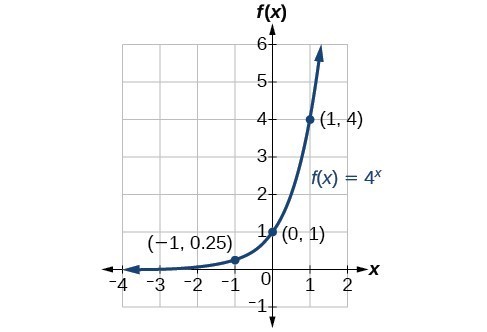
2. The domain is [latex]\left(-\infty ,\infty \right)[/latex]; the range is [latex]\left(3,\infty \right)[/latex]; the horizontal asymptote is y = 3.
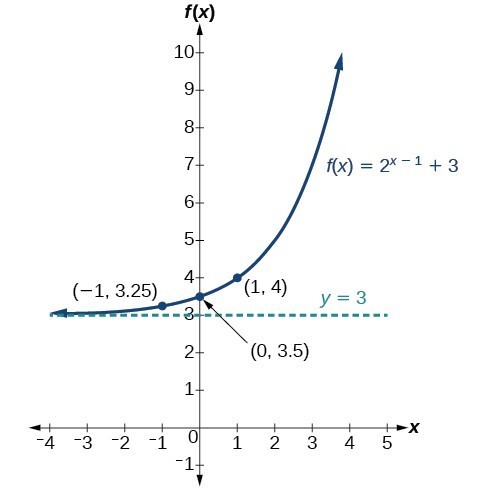
3. [latex]x\approx -1.608[/latex]
4. The domain is [latex]\left(-\infty ,\infty \right)[/latex]; the range is [latex]\left(0,\infty \right)[/latex]; the horizontal asymptote is [latex]y=0[/latex].
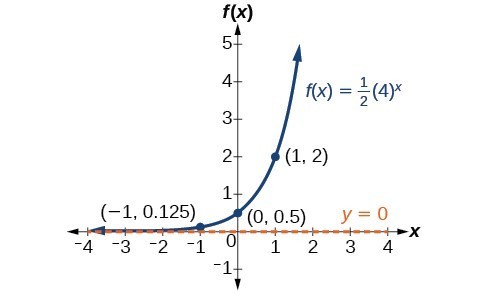
5. The domain is [latex]\left(-\infty ,\infty \right)[/latex]; the range is [latex]\left(0,\infty \right)[/latex]; the horizontal asymptote is [latex]y=0[/latex].

6. [latex]f\left(x\right)=-\frac{1}{3}{e}^{x}-2[/latex]; the domain is [latex]\left(-\infty ,\infty \right)[/latex]; the range is [latex]\left(-\infty ,2\right)[/latex]; the horizontal asymptote is [latex]y=2[/latex].
Solutions to Odd-Numbered Exercises
1. An asymptote is a line that the graph of a function approaches, as x either increases or decreases without bound. The horizontal asymptote of an exponential function tells us the limit of the function’s values as the independent variable gets either extremely large or extremely small.
3. [latex]g\left(x\right)=4{\left(3\right)}^{-x}[/latex]; y-intercept: [latex]\left(0,4\right)[/latex]; Domain: all real numbers; Range: all real numbers greater than 0.
5. [latex]g\left(x\right)=-{10}^{x}+7[/latex]; y-intercept: [latex]\left(0,6\right)[/latex]; Domain: all real numbers; Range: all real numbers less than 7.
7. [latex]g\left(x\right)=2{\left(\frac{1}{4}\right)}^{x}[/latex]; y-intercept: [latex]\left(0,\text{ 2}\right)[/latex]; Domain: all real numbers; Range: all real numbers greater than 0.
9. y-intercept: [latex]\left(0,-2\right)[/latex]
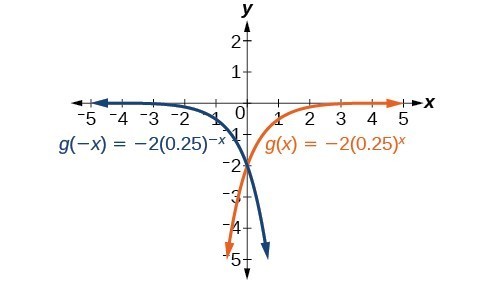
11.
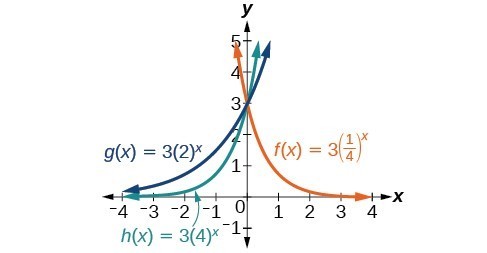
13. B
15. A
17. E
19. D
21. C
23.
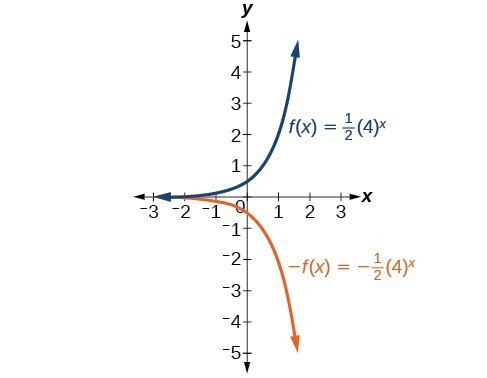
25.
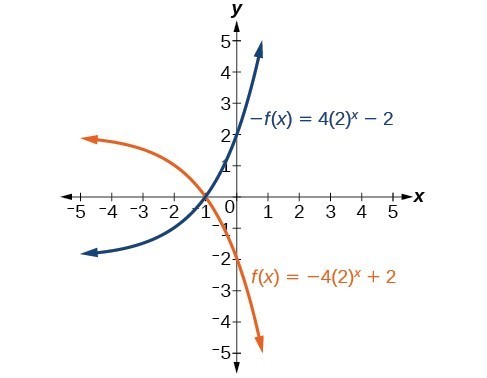
27. Horizontal asymptote: [latex]h\left(x\right)=3[/latex]; Domain: all real numbers; Range: all real numbers strictly greater than 3.
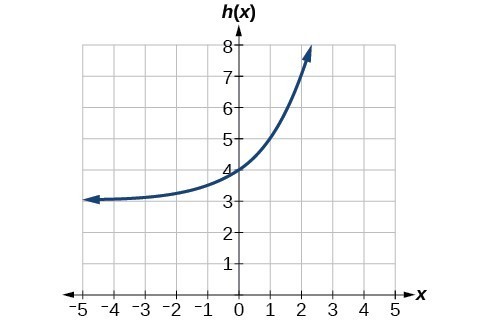
29. As [latex]x\to \infty[/latex] , [latex]f\left(x\right)\to -\infty\\[/latex] ;
As [latex]x\to -\infty[/latex] , [latex]f\left(x\right)\to -1[/latex]
31. As [latex]x\to \infty\\[/latex] , [latex]f\left(x\right)\to 2[/latex] ;
As [latex]x\to -\infty[/latex] , [latex]f\left(x\right)\to \infty[/latex]
33. [latex]f\left(x\right)={4}^{x}-3[/latex]
35. [latex]f\left(x\right)={4}^{x - 5}[/latex]
37. [latex]f\left(x\right)={4}^{-x}[/latex]
39. [latex]y=-{2}^{x}+3[/latex]
41. [latex]y=-2{\left(3\right)}^{x}+7[/latex]
43. [latex]g\left(6\right)=800+\frac{1}{3}\approx 800.3333[/latex]
45. [latex]h\left(-7\right)=-58[/latex]
47. [latex]x\approx -2.953[/latex]
49. [latex]x\approx -0.222[/latex]
51. The graph of [latex]G\left(x\right)={\left(\frac{1}{b}\right)}^{x}[/latex] is the reflection about the y-axis of the graph of [latex]F\left(x\right)={b}^{x}[/latex]; For any real number [latex]b>0[/latex] and function [latex]f\left(x\right)={b}^{x}[/latex], the graph of [latex]{\left(\frac{1}{b}\right)}^{x}[/latex] is the the reflection about the y-axis, [latex]F\left(-x\right)[/latex].
53. The graphs of [latex]g\left(x\right)[/latex] and [latex]h\left(x\right)[/latex] are the same and are a horizontal shift to the right of the graph of [latex]f\left(x\right)[/latex]; For any real number n, real number [latex]b>0[/latex], and function [latex]f\left(x\right)={b}^{x}[/latex], the graph of [latex]\left(\frac{1}{{b}^{n}}\right){b}^{x}[/latex] is the horizontal shift [latex]f\left(x-n\right)[/latex].
Candela Citations
- Precalculus. Authored by: Jay Abramson, et al.. Provided by: OpenStax. Located at: http://cnx.org/contents/fd53eae1-fa23-47c7-bb1b-972349835c3c@5.175. License: CC BY: Attribution. License Terms: Download For Free at : http://cnx.org/contents/fd53eae1-fa23-47c7-bb1b-972349835c3c@5.175.